Description: Voting
Ranked Ballot
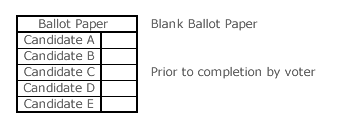
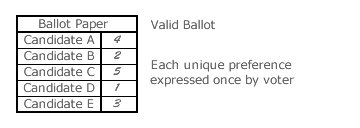
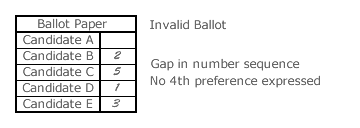
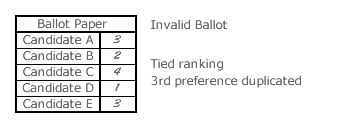
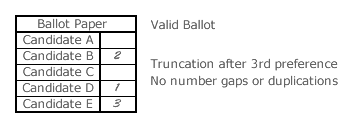
As geometric voting is a form of preferential voting, voters cast a ranked ballot. The exact format of the ballot is not important provided the preferences expressed by every voter are valid, clear and unambiguous. Some examples of ranked ballots are listed below and the ballot papers shown opposite illustrate the 'candidate listing' type.
- Candidate Listing
- Candidates are listed in alphabetical or random order and voters are instructed to enter each preference as a rank order number against the appropriate candidate.
- Written Entries
- Voters are required to enter the names of the candidates in rank order from most to least preferred.
- Matrix Ballot
- With one row per candidate and one column per preference, voters are required to mark the relevant cells to indicate their input.
- Electronic Ballot
- From most to least preferred, voters are asked to select their chosen candidate in turn from the pool of so far unselected candidates.
Using the 'candidate listing' ranked ballot paper for illustrative purposes, voters are asked to enter their preferences as digits. They are instructed to enter 1 against their first preference candidate, 2 against their second preference, 3 against their third one and so on. They should also be informed that they must not use the same number twice as tied rankings are not permitted. [The technical reasons for this prohibition are explained in the Evaluations: Clones & Teaming section of the next chapter.] Additionally, they must not skip over or omit any intermediate preferences. When using GV/CHPV, the number sequence must start with a 1 and be continuous with no gaps or duplications.
Various examples of valid and invalid ranked ballots are shown opposite.
Truncation is however permitted in GV/CHPV. This means that voters do not need to express a preference for each and every candidate. If, for any reason, a voter is unable to distinguish between two or more candidates or is unwilling to continue awarding preferences (that are always helpful) to candidates they disapprove of, then they may stop and leave no number against these remaining candidates. All voters must however express at least their first preference before truncating any later preferences.
Voting in party-list GV/CHPV elections is addressed later in the Description: Party-List section of this chapter.
Proceed to next section > Description: Counting
Return to previous page > Description: Weightings
